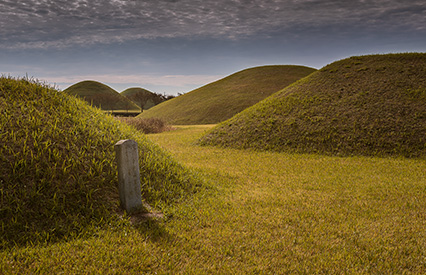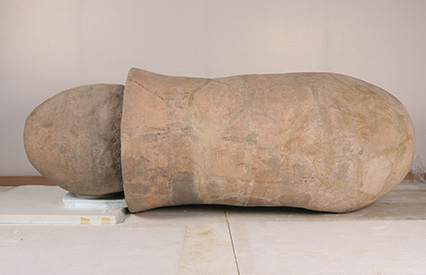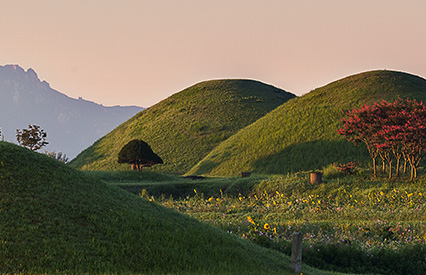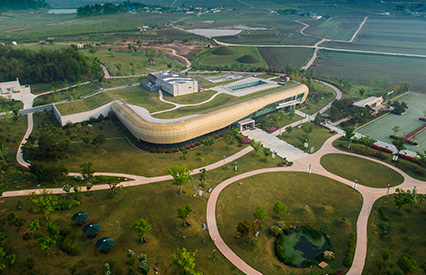Ancient Tombs in Bannam
The Ancient Tombs in Bannam are the 40 tombs from the Three Kingdoms Period found in Deoksan-ri,
Sinchon-ri, and Daedan-ri centering on Jamisan Mountain surrounded by Sampogang River, a tributary of the Yeongsangang River.
Feel the Breath of an Ancient Kingdom
Most of the tombs found in this area are round or pyramid-shaped with the top cut off.
They were first discovered during the Japanese occupation period, and massive dongneol (dok-neol) tombs, which had never been seen before in any other areas,
were excavated. Splendid artifacts that belonged to the most powerful at the time,
such as a gilt-bronze crown, gilt-bronze shoes, and sword with ring pommel, were excavated from Eulgwan Tumulus 9 in Sinchon-ri.

Keeping the Secrets of Mahan
The Ancient Tombs in Daean-ri with twelve tombs are found on the west side of the ridge of Jamisan Mountain.
These tombs are broadly divided into three groups, with tumuli 1 to 3 in the located in the northernmost part.
At the western end of the hill, tumuli 10 and 11 form the second group. Lastly, tumuli 4 to 9 and 12 located the southernmost part form the third group.
Although tumuli 8 and 9 were officially excavated in 1908, there are not much details known about them.
Tumulus 9, the largest tomb among the tombs in Daehan-ri, contained 9 coffins,
and gold rings, long swords, glass beads, and earthenware were excavated.

A Unique Tomb Design
The Ancient Tombs in Deoksan-ri are located on the east side of the ridge of Jamisan Mountain.
Only ten of them were known during the Japanese occupation period, but an archaeological survey revealed that there were a total of fourteen.
This group of tombs is divided into two groups according to their locations.
Tumuli 1 to 6 are found east of the Naju National Museum and tumuli 7 to 10 on the south.
umulus 10 is a dolbang tomb (stone chamber tomb), and it is presumed that it was created after the people of Baekje moved into the area and the indigenous tomb style (dongneol) began to disappear.
Taumulus 3 in Deoksan-ri was robbed during the Japanese colonial period, and an rchaeological survey was conducted in 2021 to study the construction method.

Gold-Bronze Crown, Revealed for the First Time
The Ancient Tombs in Sinchon-ri are located near the Naju National Museum and Ancient Tombs in Deoksan-ri.
These ancient tombs are largely divided into three groups, including tumuli 1 to 3 that are located on the east side of the Naju National Museum.
Tumuli 2 and 3, in particular, are located in the vicinity of the museum and can be seen while walking along the museum walkway.
Tumuli 4 to 6 and 7 to 9 are found on the western hillside of the Naju National Museum, just to the north of the Ancient Tombs in Deoksan-ri on the south side of the museum.
An archaeological survey of the Ancient Tombs in Sinchon-ri tomb was partially carried out during the Japanese colonial period, including Tumulus 9, and gilt-bronze coffins, gilt-bronze shoes,
and sword with ring pommel were excavated at the time. Then, during a re-excavation project in 1999, two pieces of cylindrical earthenware that adorned the top of the tomb were uncovered.

The Ancient Tombs in Bannam provide valuable information on the changes in local culture since the arrival of the people of Baekje in the Jeollanam-do region, as there is a mix of two different tomb styles.
Also, the fact that cylindrical earthenware unique to the Japanese were found here shows that people engaged in international exchanges at the time.